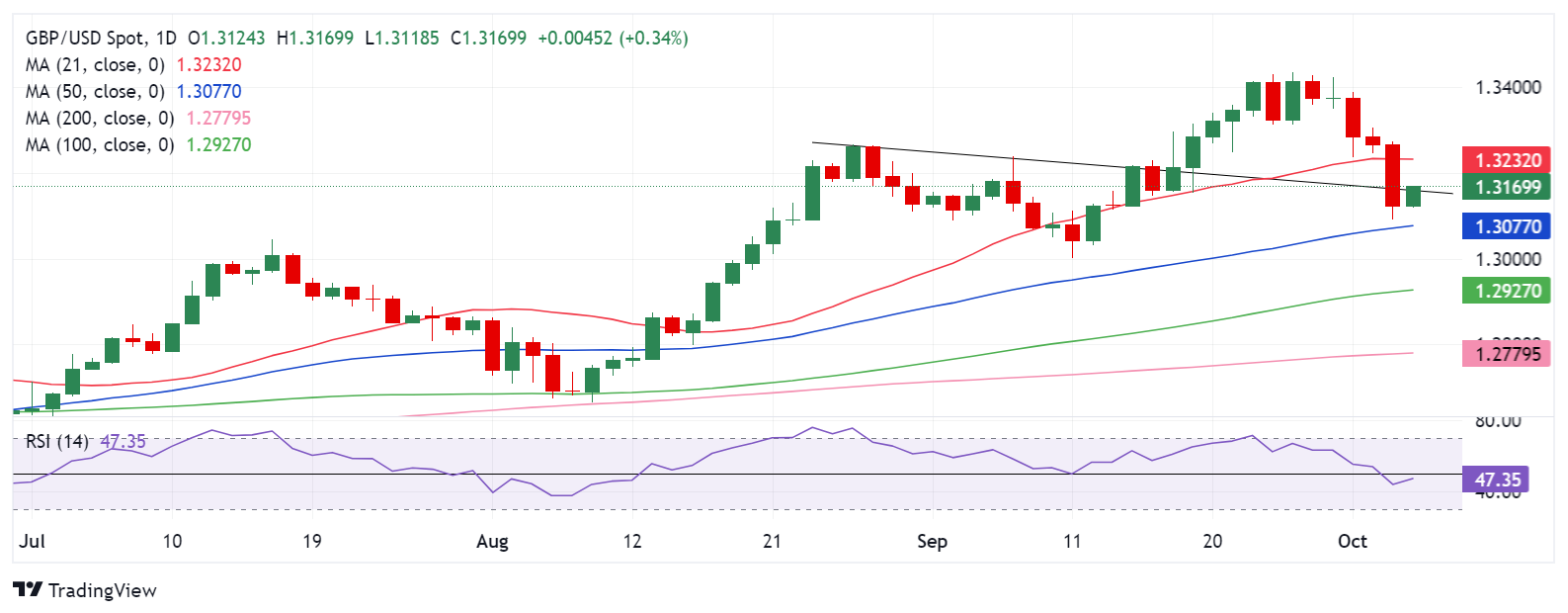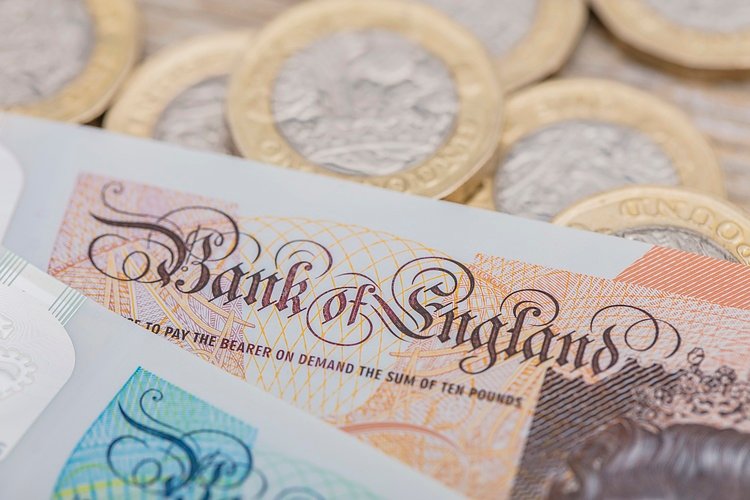- The Pound Sterling fell for the second week in a row against the US Dollar.
- GBP/USD gears up for top-tier UK economic data in the holiday-shortened week ahead.
- Technically, risks remain skewed to the downside for the Pound Sterling.
The Pound Sterling (GBP) booked the second straight weekly loss against the US Dollar (USD), sending the GBP/USD pair to the lowest level in a month below 1.3050.
Pound Sterling failed again versus the US Dollar
A surprisingly strong United States (US) Nonfarm Payrolls (NFP) report for September suggested that the US labor market is in a healthier condition than initially feared, ruling out any possibility that the Federal Reserve (Fed) opting for a 50 basis points (bps) interest rate cut in November.
Markets expected a 94% chance of a 25 bps rate cut at its next meeting after the US employment report, the CME Group’s FedWatch Tool showed. Currently, markets price in an 86% probability of such a move, and there is no big change despite the hot US Consumer Price Index (CPI) data for September, released on Thursday. Discouraging US Jobless Claims overshadowed the consumer inflation data, keeping the November rate cut hopes alive and kicking.
Data released by the US Labor Department showed on Thursday that Initial Jobless Claims surged by 33,000 last week to a seasonally adjusted 258,000 for the week ended October. 5. Meanwhile, US annual CPI inflation dropped to 2.4% in September from 2.5% in August, the lowest level since February 2021, although it still came in above the estimated 2.3% print. The CPI increased by 0.2% over the month in September, matching August’s increase and surpassing 0.1% expectations.
Expectations of a smaller rate cut by the Fed at its upcoming meeting remained the key driver throughout the week, allowing the US Dollar to extend its recovery to a fresh two-month high against its major rivals. Therefore, the GBP/USD pair continued its downside momentum, hitting the lowest level in a month below 1.3050.
From the UK side, there were no high-impact economic data releases until Friday’s monthly Gross Domestic Product (GDP). The UK economy grew 0.2% in August on a monthly basis, data published by the Office for National Statistics (ONS) showed. The reading aligned with the market forecast.
Pound Sterling traders continued to assess the odds of a Bank of England (BoE) rate cut next month, following the contradictory messages from BoE policymakers last week. BoE Chief Economist Huw Pill said earlier this month that there is “ample reason for caution in assessing the dissipation of inflation persistence.”
He added that the “need for such caution points to a gradual withdrawal of monetary policy restriction.” Just a day before Pill’s appearance, Governor Andrew Bailey noted that the UK central bank “could become a bit more activist on rate cuts if there’s further good news on inflation.”
Top-tier UK economic data on tap
The focus now shifts to a batch of high-impact economic data from the United Kingdom, which could provide a sense of what markets expect from the Bank of England (BoE) next month.
The US economic calendar is relatively data-light, with the only Retail Sales data for September of note.
It’s a holiday-shortened week, as US markets are closed on Monday on account of Columbus Day. That puts the focus on Tuesday’s UK labor data.
Wednesday will feature the UK CPI data for September, which will have a significant impact on the BoE’s interest rate move in November, as well as on the Pound Sterling. On Thursday, the US Retail Sales report will be published alongside the releases of the weekly Jobless Claims and Philly Fed Manufacturing Index for October.
The European Central Bank (ECB) is set to announce its policy decision on Thursday, which could have a EUR/GBP cross-driven ‘rub-off’ effect on the GBP/USD pair.
Chinese activity data on Friday could affect risk trends, eventually influencing the risk-sensitive British Pound. Later that day, the UK Retail Sales data for September will be reported, followed by the mid-tier US housing data.
Besides, speeches from Fed and BoE officials will grab attention while Mid-East geopolitical developments will also be closely eyed.
GBP/USD: Technical Outlook
The GBP/USD pair finally yielded a downside break of the critical 50-day Simple Moving Average (SMA) at 1.3101 on Wednesday, having managed to defend that support the prior week.
Acceptance under that level helped sellers to flex their muscles, with more downside likely on the cards, as the 14-day Relative Strength Index (RSI) remains well below the 50 level, currently near 40.
If the selling around the Pound Sterling intensifies, the 100-day SMA at 1.2945 would emerge as the next rescue point for buyers.
Further down, the 1.2790 region will be put to the test. That zone is the confluence of the August 15 low and the 200-day SMA.
Alternatively, recapturing the 50-day SMA at 1.3101 on a daily closing basis is crucial to initiate any meaningful recovery toward the 21-day SMA at 1.3225.
Pound Sterling will then target the 1.3300 round level should the upswing gather stream.
Inflation FAQs
Inflation measures the rise in the price of a representative basket of goods and services. Headline inflation is usually expressed as a percentage change on a month-on-month (MoM) and year-on-year (YoY) basis. Core inflation excludes more volatile elements such as food and fuel which can fluctuate because of geopolitical and seasonal factors. Core inflation is the figure economists focus on and is the level targeted by central banks, which are mandated to keep inflation at a manageable level, usually around 2%.
The Consumer Price Index (CPI) measures the change in prices of a basket of goods and services over a period of time. It is usually expressed as a percentage change on a month-on-month (MoM) and year-on-year (YoY) basis. Core CPI is the figure targeted by central banks as it excludes volatile food and fuel inputs. When Core CPI rises above 2% it usually results in higher interest rates and vice versa when it falls below 2%. Since higher interest rates are positive for a currency, higher inflation usually results in a stronger currency. The opposite is true when inflation falls.
Although it may seem counter-intuitive, high inflation in a country pushes up the value of its currency and vice versa for lower inflation. This is because the central bank will normally raise interest rates to combat the higher inflation, which attract more global capital inflows from investors looking for a lucrative place to park their money.
Formerly, Gold was the asset investors turned to in times of high inflation because it preserved its value, and whilst investors will often still buy Gold for its safe-haven properties in times of extreme market turmoil, this is not the case most of the time. This is because when inflation is high, central banks will put up interest rates to combat it. Higher interest rates are negative for Gold because they increase the opportunity-cost of holding Gold vis-a-vis an interest-bearing asset or placing the money in a cash deposit account. On the flipside, lower inflation tends to be positive for Gold as it brings interest rates down, making the bright metal a more viable investment alternative.










